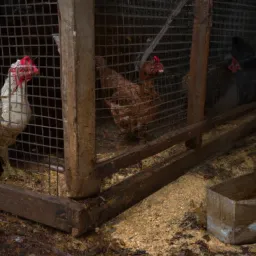The Ultimate Guide to Building Your Own Chicken Coop
Are you ready to embark on the exciting journey of building your own chicken coop? If so, then this ultimate guide is just what you need.
Building a chicken coop can be a fun and rewarding experience that will provide you with fresh eggs daily while also giving you the opportunity to bond with your feathered friends.
In this guide, we’ll cover everything from choosing the right breed for your coop to designing it and gathering materials, all the way up to constructing it step-by-step. Let’s get started!
Introduction to Building Your Own Chicken Coop
Building your own chicken coop can seem like an intimidating task at first glance, but it doesn’t have to be.
With proper planning and preparation, anyone can build their dream chicken coop in no time.
Before diving into the details of how to build a chicken coop, let’s take a moment to discuss why building one yourself might be the best choice for you.
For starters, building your own chicken coop allows you to customize every aspect of its design to fit your specific needs and preferences.
Whether you want a small backyard coop or a larger free-range setup, building it yourself gives you complete control over the final product.
Also, building your own chicken coop can save you money compared to buying pre-made ones, especially if you use recycled materials.
Finally, building a chicken coop provides an excellent opportunity to learn new skills and gain valuable DIY experience.
Choosing the Right Chicken Breed for Your Coop
One of the most important decisions when building a chicken coop is which breed to choose.
See also The Ultimate Guide to Building Your Own Chicken Coop
There are many factors to consider such as egg production, temperament, space requirements, and climate compatibility.
Some popular breeds include:
- Leghorns
- Rhode Island Reds
- Buff Orpingtons
- Plymouth Rocks
Research each breed carefully before making a decision based on your individual needs and goals.
Designing and Planning Your Chicken Coop
Once you’ve chosen your ideal chicken breed, it’s time to start designing and planning your coop. Consider factors such as size, layout, ventilation, lighting, and accessibility.
A good rule of thumb is to allow at least four square feet per bird inside the coop, and six square feet outside.
You may also want to incorporate features such as nest boxes, roosts, feeders, and waterers. Sketch out your ideas on paper before moving on to the next step.
Materials Needed for Building a Chicken Coop
Now that you’ve planned out your perfect chicken coop, it’s time to gather the necessary materials.
Depending on your design, you may need items such as lumber, wire mesh, shingles, insulation, and hardware.
Consider using recycled materials whenever possible to keep costs down. Make sure to purchase high-quality materials that will stand up to weather conditions and predators.

Step-by-Step Instructions for Constructing Your Chicken Coop
With your plans in hand and materials gathered, it’s finally time to begin
construction.
Follow these steps to ensure a successful outcome:
- Build the floor frame by laying out the pressure-treated 2x4s and attaching them together with screws.
- Attach the plywood sheet to the floor frame, leaving a slight gap around the edges for drainage.
See also 5 Gadgets to Boost Coop Security & Protect Chickens From Predators
- Cut out openings for the door and windows, and attach the doors and window frames.
- Install the roof trusses and sheathing, making sure they are level and secure.
- Add siding to the walls and trim any excess material.
- Attach the chicken wire to the exterior of the coop, covering all gaps and spaces.
- Install the nest box(es), roost(s), feeders, and waterers according to your plan.
- Seal any remaining gaps or holes with caulking or other sealing agents.
- Paint or stain the finished coop to protect against weather damage.
Congratulations – you’ve successfully built your very own chicken coop! Now all that’s left to do is move in your flock of happy hens and enjoy the benefits of fresh eggs every day.
